Joint Offloading Decision and Resource Allocation in Mobile Edge Computing-Enabled Satellite-Terrestrial Network
Abstract
:1. Introduction
- The system model of MEC-enabled STN is designed, which utilizes the satellite-terrestrial cooperation to provide MEC services for UEs in the rural area without coverage of terrestrial networks. The joint offloading decision and resource allocation problem to minimize the task completion delay of all UEs is formulated, and then decomposed into the task offloading decision problem and computing resource allocation problem.
- A joint offloading decision and resource allocation scheme is proposed. The computing resource allocation problem is first decomposed into two sub-problems, which is according to the LEO satellite and the BS, respectively. Both sub-problems are convex and can be solved by Lagrange multiplier method. The task offloading decision problem is considered as a multi-UEs task offloading game, which is proved to be an exact potential game (EPG) and reach a Nash equilibrium (NE) within a finite number of iterations.
- The performance of the proposed scheme is evaluated by extensive simulations. The simulation results denote that the proposed scheme can achieve better performance gain compared with other baseline schemes.
2. Related Work
3. System Model
3.1. Network Model
3.2. Channel Model
3.3. Computation Model
4. Problem Formulation
5. Algorithm Design
5.1. Resource Allocation
5.2. Offloading Decision
5.3. Joint Offloading Decision and Resource Allocation
| Algorithm 1 JODRA-PGLMC |
|
6. Results and Discussion
6.1. Simulation Parameter
6.2. Simulation Results and Disscusion
7. Conclusions
Author Contributions
Funding
Institutional Review Board Statement
Informed Consent Statement
Data Availability Statement
Acknowledgments
Conflicts of Interest
References
- Zhang, L.; Chai, R.; Yang, T.; Chen, Q. Min-Max Worst-Case Design for Computation Offloading in Multi-user MEC System. In Proceedings of the IEEE INFOCOM 2020—IEEE Conference on Computer Communications Workshops (INFOCOM WKSHPS), Toronto, ON, Canada, 6–9 July 2020; pp. 1075–1080. [Google Scholar] [CrossRef]
- Liu, J.; Zhang, Q. Computation Resource Allocation for Heterogeneous Time-Critical IoT Services in MEC. In Proceedings of the 2020 IEEE Wireless Communications and Networking Conference (WCNC), Seoul, Korea, 25–28 May 2020; pp. 1–6. [Google Scholar] [CrossRef]
- Huang, M.; Liu, W.; Wang, T.; Liu, A.; Zhang, S. A Cloud–MEC Collaborative Task Offloading Scheme With Service Orchestration. IEEE Internet Things J. 2020, 7, 5792–5805. [Google Scholar] [CrossRef]
- Ma, Y.; Liang, W.; Huang, M.; Xu, W.; Guo, S. Virtual Network Function Service Provisioning in MEC via Trading Off the Usages between Computing and Communication Resources. IEEE Trans. Cloud Comput. 2020; in press. [Google Scholar] [CrossRef]
- Li, D.; Jin, Y.; Liu, H. Resource Allocation Strategy of Edge Systems Based on Task Priority and an Optimal Integer Linear Programming Algorithm. Symmetry 2020, 12, 972. [Google Scholar] [CrossRef]
- Berno, M.; Alcaraz, J.J.; Rossi, M. On the Allocation of Computing Tasks under QoS Constraints in Hierarchical MEC Architectures. In Proceedings of the 2019 Fourth International Conference on Fog and Mobile Edge Computing (FMEC), Rome, Italy, 10–13 June 2019; pp. 37–44. [Google Scholar] [CrossRef]
- Chen, Y.; Zhang, N.; Zhang, Y.; Chen, X.; Wu, W.; Shen, X. Energy Efficient Dynamic Offloading in Mobile Edge Computing for Internet of Things. IEEE Trans. Cloud Comput. 2021, 9, 1050–1060. [Google Scholar] [CrossRef] [Green Version]
- Chen, S.; Liang, Y.C.; Sun, S.; Kang, S.; Cheng, W.; Peng, M. Vision, Requirements, and Technology Trend of 6G: How to Tackle the Challenges of System Coverage, Capacity, User Data-Rate and Movement Speed. IEEE Wirel. Commun. 2020, 27, 218–228. [Google Scholar] [CrossRef] [Green Version]
- Zhang, Y.; Tang, Y.; Wang, W. Service Deployment and Service Request Optimization Scheduling in MEC enabled LEO Networks. In Proceedings of the 2021 International Conference on Computer Communications and Networks (ICCCN), Athens, Greece, 19–22 July 2021; pp. 1–6. [Google Scholar] [CrossRef]
- Wang, P.; Zhang, J.; Zhang, X.; Yan, Z.; Evans, B.G.; Wang, W. Convergence of Satellite and Terrestrial Networks: A Comprehensive Survey. IEEE Access 2020, 8, 5550–5588. [Google Scholar] [CrossRef]
- Deng, R.; Di, B.; Chen, S.; Sun, S.; Song, L. Ultra-Dense LEO Satellite Offloading for Terrestrial Networks: How Much to Pay the Satellite Operator? IEEE Trans. Wirel. Commun. 2020, 19, 6240–6254. [Google Scholar] [CrossRef]
- Wang, B.; Feng, T.; Huang, D. A Joint Computation Offloading and Resource Allocation Strategy for LEO Satellite Edge Computing System. In Proceedings of the 2020 IEEE 20th International Conference on Communication Technology (ICCT), Nanning, China, 28–31 October 2020; pp. 649–655. [Google Scholar] [CrossRef]
- Li, C.; Zhang, Y.; Hao, X.; Huang, T. Jointly optimized request dispatching and service placement for MEC in LEO network. China Commun. 2020, 17, 199–208. [Google Scholar] [CrossRef]
- Tang, Q.Q.; Xie, R.C.; Liu, X.; Zhang, Y.S.; He, C.; Li, C.C.; Huang, T. MEC enabled satellite-terrestrial network: Architecture, key technique and challenge. J. Commun. 2020, 41, 162–181. (In Chinese) [Google Scholar]
- Li, Z.; Li, M.; Wang, Q. Predator–Prey Model Based Asymmetry Resource Allocation in Satellite–Terrestrial Network. Symmetry 2021, 13, 2113. [Google Scholar] [CrossRef]
- Feng, W.; Liu, H.; Yao, Y.; Cao, D.; Zhao, M. Latency-Aware Offloading for Mobile Edge Computing Networks. IEEE Commun. Lett. 2021, 25, 2673–2677. [Google Scholar] [CrossRef]
- Wang, Y.; Zhang, J.; Zhang, X.; Wang, P.; Liu, L. A Computation Offloading Strategy in Satellite Terrestrial Networks with Double Edge Computing. In Proceedings of the 2018 IEEE International Conference on Communication Systems (ICCS), Chengdu, China, 19–21 December 2018; pp. 450–455. [Google Scholar] [CrossRef]
- Zhang, Z.; Zhang, W.; Tseng, F.H. Satellite Mobile Edge Computing: Improving QoS of High-Speed Satellite-Terrestrial Networks Using Edge Computing Techniques. IEEE Netw. 2019, 33, 70–76. [Google Scholar] [CrossRef]
- Cheng, N.; Lyu, F.; Quan, W.; Zhou, C.; He, H.; Shi, W. Space/Aerial-Assisted Computing Offloading for IoT Applications: A Learning-Based Approach. IEEE J. Sel. Areas Commun. 2019, 37, 1117–1129. [Google Scholar] [CrossRef]
- Xie, R.; Tang, Q.; Wang, Q.; Liu, X.; Yu, F.R.; Huang, T. Satellite-Terrestrial Integrated Edge Computing Networks: Architecture, Challenges, and Open Issues. IEEE Netw. 2020, 34, 224–231. [Google Scholar] [CrossRef]
- Zhang, J.; Zhang, X.; Wang, P.; Liu, L.; Wang, Y. Double-edge intelligent integrated satellite terrestrial networks. China Commun. 2020, 17, 128–146. [Google Scholar] [CrossRef]
- Chen, T.; Liu, J.; Ye, Q.; Zhuang, W.; Zhang, W.; Huang, T.; Liu, Y. Learning-based Computation Offloading for IoRT through Ka/Q-Band Satellite-Terrestrial Integrated Networks. IEEE Internet Things J. 2021; in press. [Google Scholar] [CrossRef]
- Song, Z.; Hao, Y.; Liu, Y.; Sun, X. Energy-Efficient Multiaccess Edge Computing for Terrestrial-Satellite Internet of Things. IEEE Internet Things J. 2021, 8, 14202–14218. [Google Scholar] [CrossRef]
- Pang, B.; Gu, S.; Zhang, Q.; Zhang, N.; Xiang, W. CCOS: A Coded Computation Offloading Strategy for Satellite-Terrestrial Integrated Networks. In Proceedings of the 2021 International Wireless Communications and Mobile Computing (IWCMC), Harbin, China, 28 June–2 July 2021; pp. 242–247. [Google Scholar] [CrossRef]
- Wang, B.; Li, X.; Huang, D.; Xie, J. A Profit Maximization Strategy of MEC Resource Provider in the Satellite-Terrestrial Double Edge Computing System. In Proceedings of the 2021 IEEE 21st International Conference on Communication Technology (ICCT), Tianjin, China, 13–16 October 2021; pp. 906–912. [Google Scholar] [CrossRef]
- 3rd Generation Partnership Project; Technical Specification Group Radio Access Network; Study on New Radio (NR) to Support Non-Terrestrial Networks (Release 15). 3GPP TR 38.811 V15.4.0. 2020. Available online: https://www.3gpp.org/ftp/Specs/archive/38_series/38.811 (accessed on 10 February 2022).
- Lee, Y.; Choi, J.P. Connectivity Analysis of Mega-Constellation Satellite Networks With Optical Intersatellite Links. IEEE Trans. Aerosp. Electron. Syst. 2021, 57, 4213–4226. [Google Scholar] [CrossRef]
- Tang, Q.; Fei, Z.; Li, B.; Han, Z. Computation Offloading in LEO Satellite Networks With Hybrid Cloud and Edge Computing. IEEE Internet Things J. 2021, 8, 9164–9176. [Google Scholar] [CrossRef]
- Cui, G.; Li, X.; Xu, L.; Wang, W. Latency and Energy Optimization for MEC Enhanced SAT-IoT Networks. IEEE Access 2020, 8, 55915–55926. [Google Scholar] [CrossRef]
- Zhao, Z.; Zhao, R.; Xia, J.; Lei, X.; Li, D.; Yuen, C.; Fan, L. A Novel Framework of Three-Hierarchical Offloading Optimization for MEC in Industrial IoT Networks. IEEE Trans. Ind. Inform. 2020, 16, 5424–5434. [Google Scholar] [CrossRef]
- Ding, Y.; Li, K.; Liu, C.; Li, K. A Potential Game Theoretic Approach to Computation Offloading Strategy Optimization in End-Edge-Cloud Computing. IEEE Trans. Parallel Distrib. Syst. 2022, 33, 1503–1519. [Google Scholar] [CrossRef]
- Monderer, D.; Shapley, L.S. Potential Games. Games Econ. Behav. 1996, 14, 124–143. [Google Scholar] [CrossRef]
- Wang, E.; Dong, P.; Xu, Y.; Li, D.; Wang, L.; Yang, Y. Distributed Game-Theoretical Task Offloading for Mobile Edge Computing. In Proceedings of the 2021 IEEE 18th International Conference on Mobile Ad Hoc and Smart Systems (MASS), Denver, CO, USA, 4–7 October 2021; pp. 216–224. [Google Scholar] [CrossRef]
- Fang, T.; Yuan, F.; Ao, L.; Chen, J. Joint Task Offloading, D2D Pairing, and Resource Allocation in Device-Enhanced MEC: A Potential Game Approach. IEEE Internet Things J. 2022, 9, 3226–3237. [Google Scholar] [CrossRef]
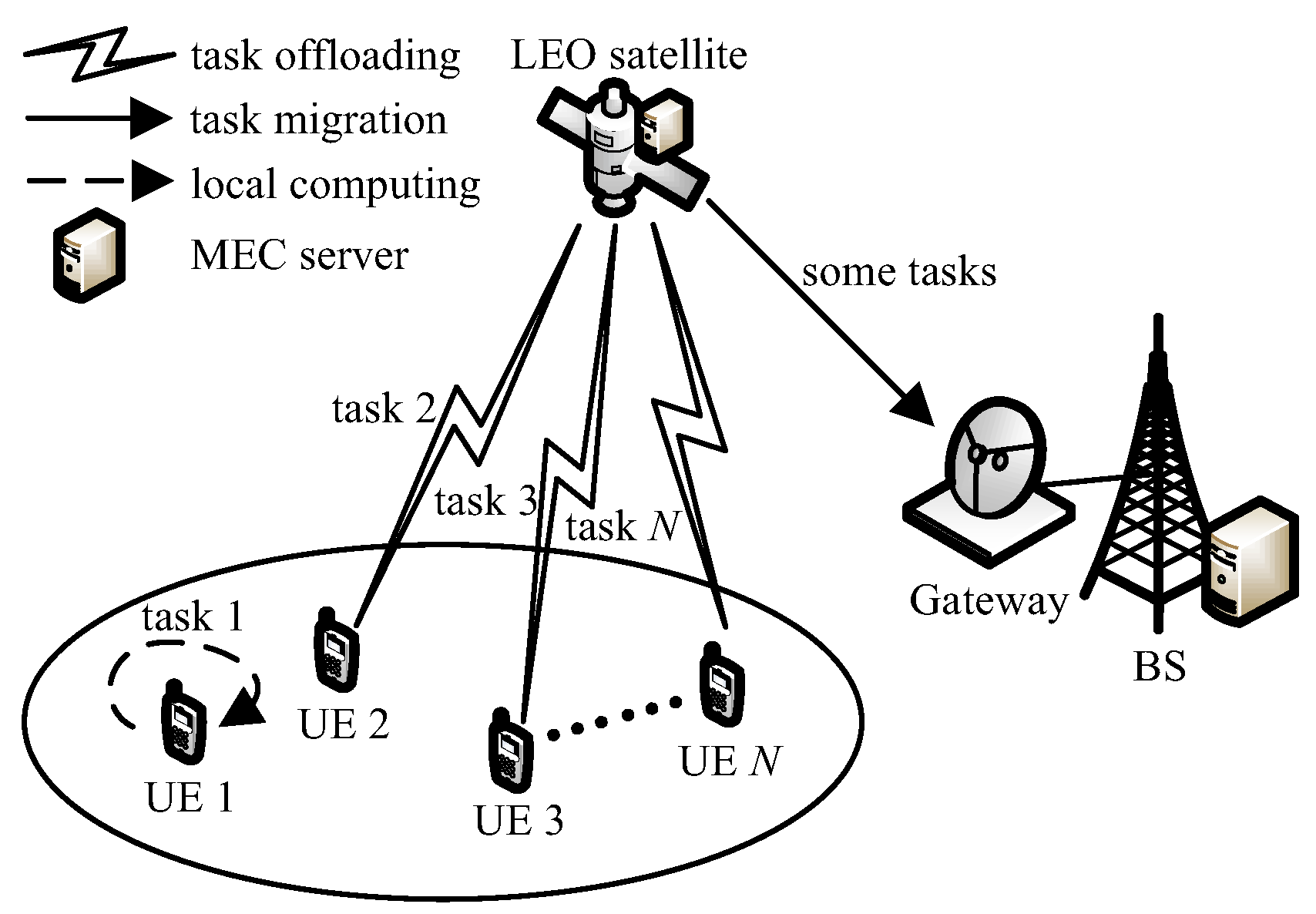
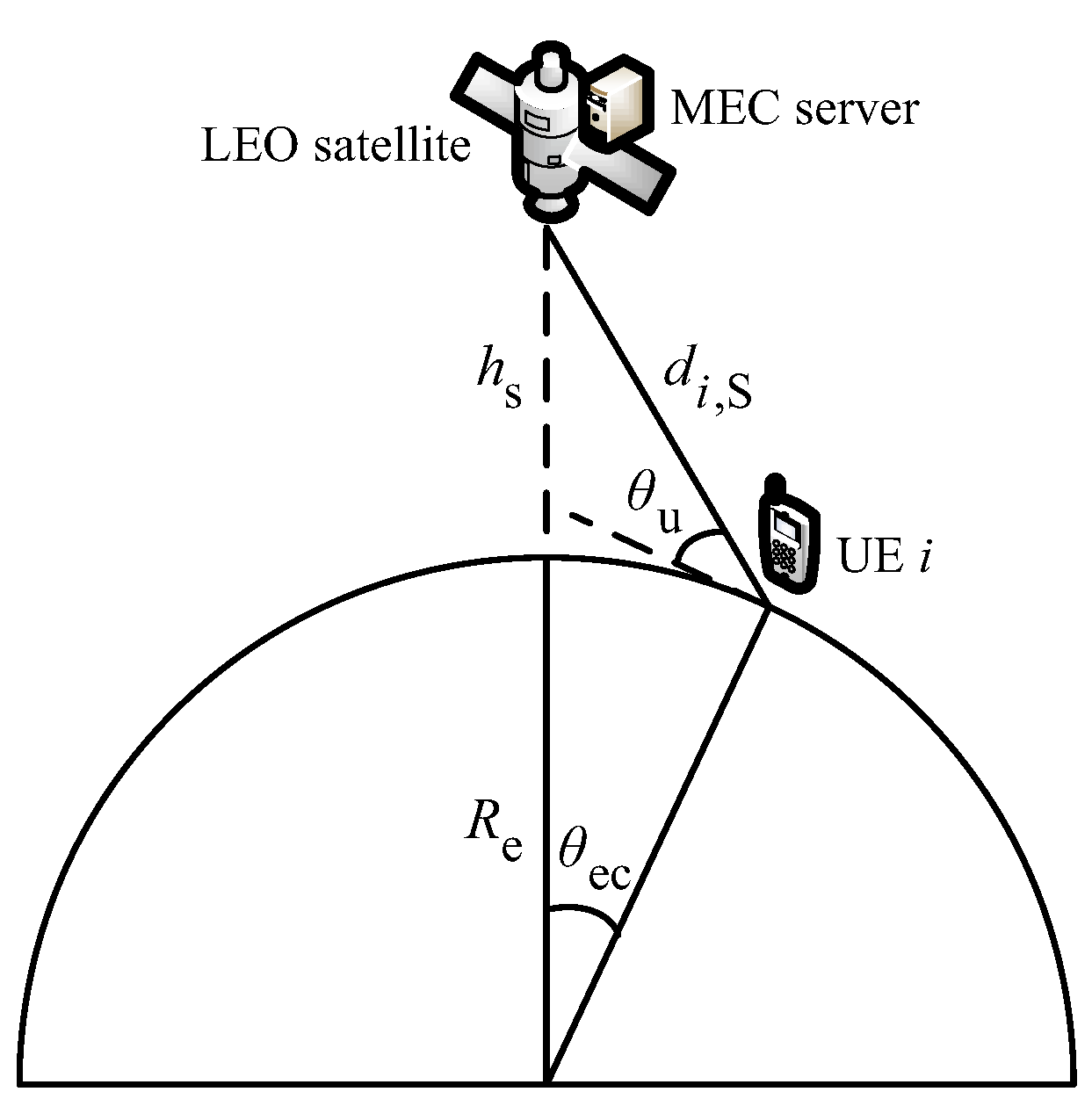

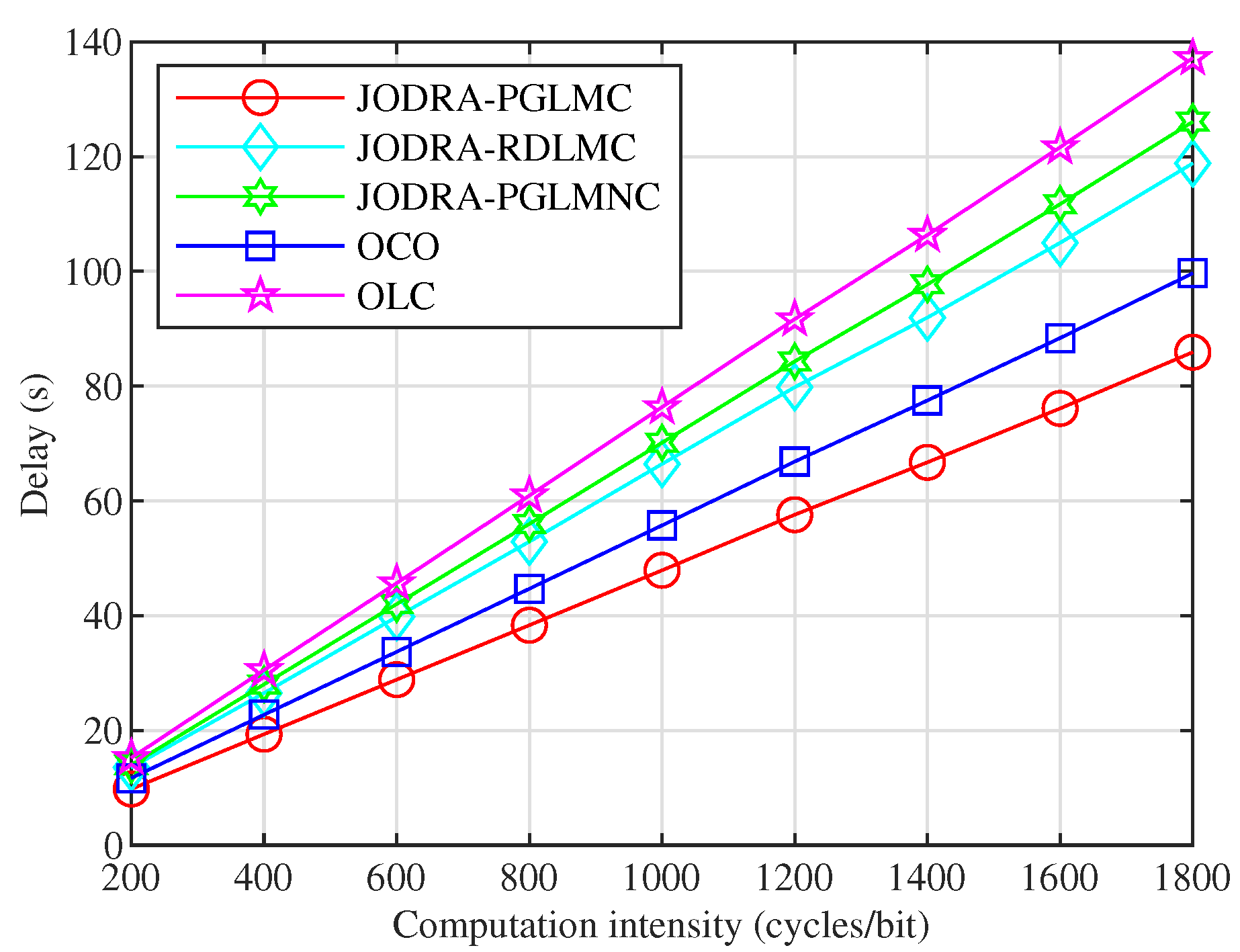
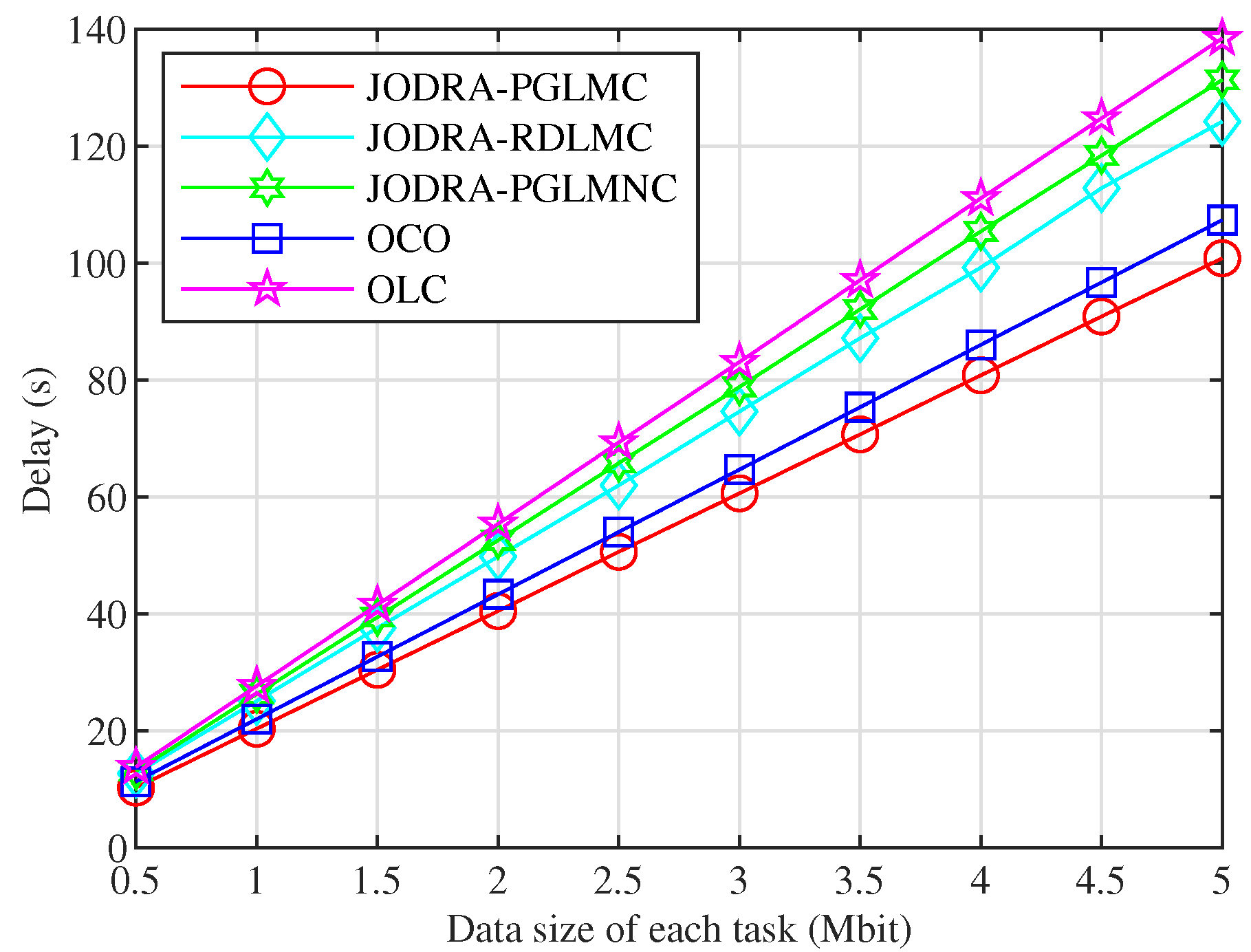
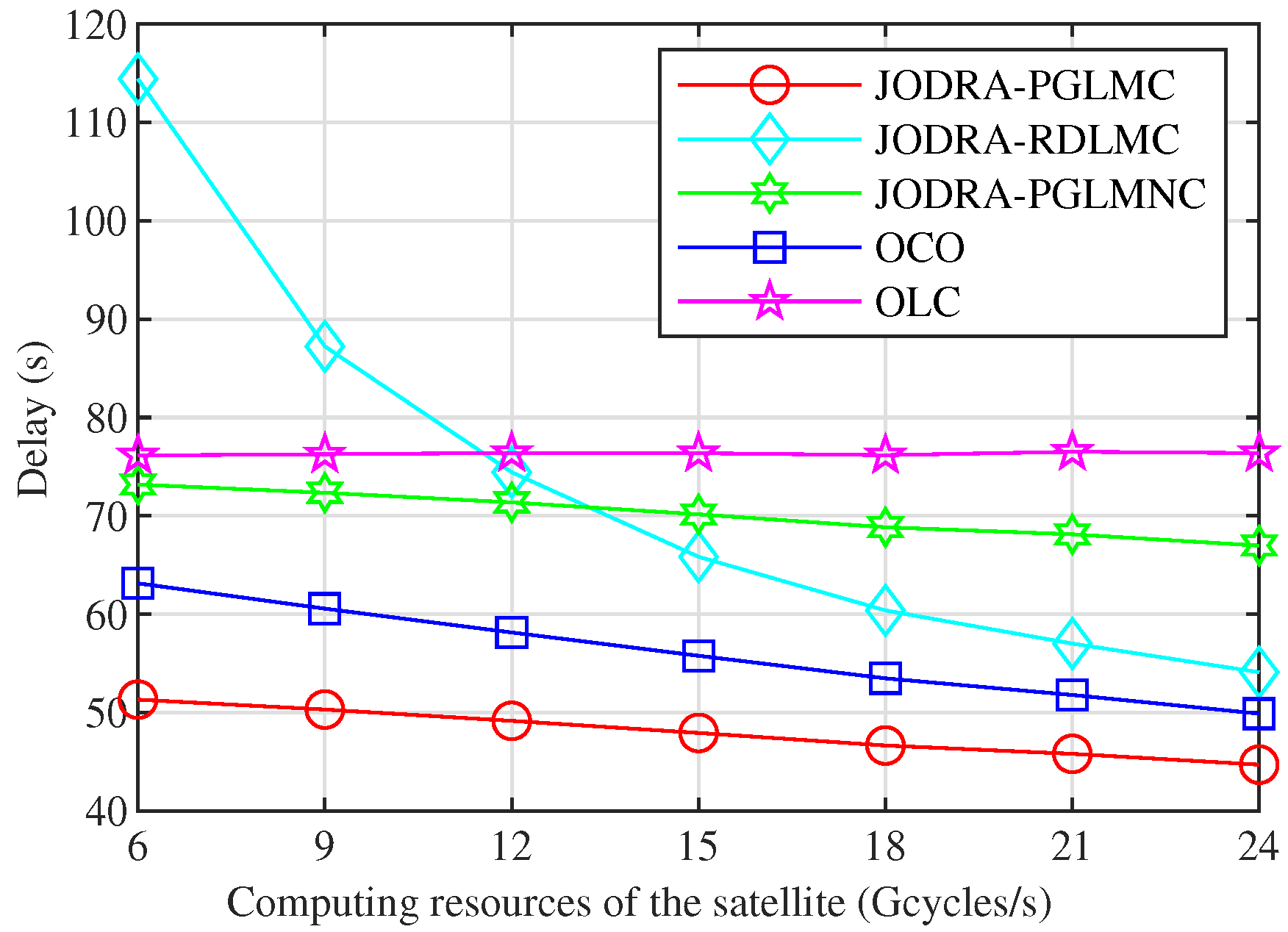
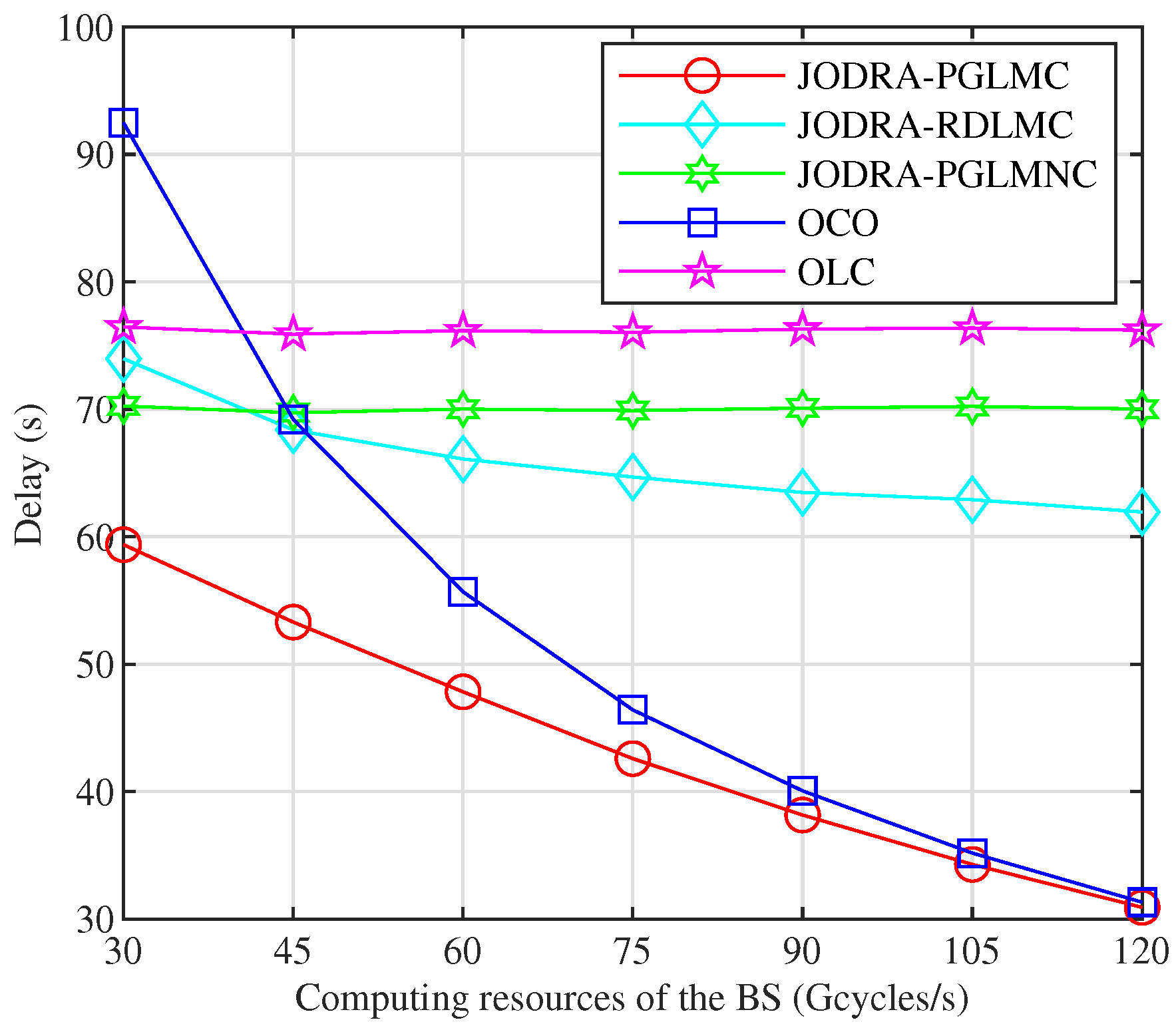
| Parameter | Value | Parameter | Value |
|---|---|---|---|
| N | 40 | 2 W | |
| 1000 cycles/bit | [0.5, 5] Mbit | ||
| [1, 2] GHz | 43.2 dBi | ||
| 800 MHz | 800 MHz | ||
| 30 GHz | 20 GHz | ||
| −203 dBm/Hz | −203 dBm/Hz | ||
| 780 km | P | 50 W | |
| 0.5 m | 0.33 m | ||
| 15 Gcycles/s | 60 Gcycles/s | ||
| 7.3 m | c | m/s | |
| 6371 km | 2000 | ||
| [] | [] |
| Parameter | Value | Value | Value | Value | Value | Value | Value | Value | Value |
|---|---|---|---|---|---|---|---|---|---|
| (dB) | 25.43 | 12.72 | 8.40 | 6.52 | 5.24 | 4.57 | 4.02 | 3.70 | 3.62 |
| (dB) | 7.04 | 7.47 | 7.18 | 6.88 | 5.28 | 4.92 | 3.40 | 2.22 | 2.28 |
Publisher’s Note: MDPI stays neutral with regard to jurisdictional claims in published maps and institutional affiliations. |
© 2022 by the authors. Licensee MDPI, Basel, Switzerland. This article is an open access article distributed under the terms and conditions of the Creative Commons Attribution (CC BY) license (https://creativecommons.org/licenses/by/4.0/).
Share and Cite
Tong, M.; Wang, X.; Li, S.; Peng, L. Joint Offloading Decision and Resource Allocation in Mobile Edge Computing-Enabled Satellite-Terrestrial Network. Symmetry 2022, 14, 564. https://doi.org/10.3390/sym14030564
Tong M, Wang X, Li S, Peng L. Joint Offloading Decision and Resource Allocation in Mobile Edge Computing-Enabled Satellite-Terrestrial Network. Symmetry. 2022; 14(3):564. https://doi.org/10.3390/sym14030564
Chicago/Turabian StyleTong, Minglei, Xiaoxiang Wang, Song Li, and Liang Peng. 2022. "Joint Offloading Decision and Resource Allocation in Mobile Edge Computing-Enabled Satellite-Terrestrial Network" Symmetry 14, no. 3: 564. https://doi.org/10.3390/sym14030564
APA StyleTong, M., Wang, X., Li, S., & Peng, L. (2022). Joint Offloading Decision and Resource Allocation in Mobile Edge Computing-Enabled Satellite-Terrestrial Network. Symmetry, 14(3), 564. https://doi.org/10.3390/sym14030564






